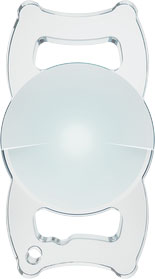- Home
- Resource Library
- IOL (Intraocular lens) & ICL (Implantable contact lens)
- Lenstec SBL-3 ClearView MIOL
Introducing the Lenstec SBL-3 ClearView MIOL

A top contender on the intraocular lens (IOL) market is the FDA-approved SBL-3 IOL from Lenstec, Inc. Also known as the ClearView 3, this lens offers improved vision and reduced reliance on glasses and contact lenses for cataract patients. As a multifocal intraocular lens, the ClearView 3 offers a wider range of vision than more common monofocal IOLs.
The SBL-3 multifocal intraocular lens offers a different approach than other multifocal IOLs. Unlike traditional multifocal intraocular lenses that use “concentric ring” technology, the SBL-3 has a “segmented” design. This technology reduces the transition zones and offers better visual performance.
The lens has a large depth of focus, correcting refractive errors at near (UNVA), intermediate (UIVA), and distance vision (UVDA). All IOLs offer good refractive outcomes for distance vision; the SBL-3s improved near vision means you can put away the reading glasses.
This next-generation asymmetric lens reduces visual disturbances such as halos and starbursts, otherwise known as dysphotopsias.
What are the benefits of the ClearView 3 IOL?
Performance and precision
The ClearView 3 is available in 0.25 diopter power increments, allowing our cataract surgeons to finely tune your lens for the best possible quality of vision.
Before receiving FDA approval, the ClearView 3 underwent a clinical trial that showed high levels of patient satisfaction and visual outcomes. Over 90% of patients had binocular visual acuities of 20/25 or better at all distances and over 93% achieved complete spectacle independence.
Safety and compatibility
The lens is deemed suitable for adults with cataracts in need of eye surgery with minimal astigmatism.
This IOL is made of a safe, hydrophobic acrylic material and replaces your natural lens. Its bi-aspheric, square-edged design fits comfortably and securely in place.
This flexible material also makes IOL implantation a quick, seamless process.
What are the risks of the SBL-3?
Like all medical solutions, the Lenstec ClearView 3 isn’t completely without risk. While a vast majority of patients won’t encounter problems, it’s good to be informed.
Some risks of the ClearView 3 include:
- Lens displacement: There’s a possibility of lens misalignment which could affect vision and require lens repositioning.
- Postoperative complications: Some patients might face inflammation or infection after implantation.
- Light sensitivity: A temporary increase in light sensitivity might be experienced by some.
- Visual disturbances: A few patients could experience minor visual disturbances.
- The SBL-3 MIOL is not advised for individuals with certain conditions, including glaucoma, corneal diseases, or retinal detachment.
IOL comparisons
When compared to other lenses like the Tecnis Synergy IOL, Synergy is recognized for its vision range and retinal protection against blue light. While both lenses aim for enhanced vision, the SBL-3 offers features such as reduced visual disturbances and contrast sensitivity, that set it apart from other IOLs.
Compared to the Eyhance IOL, the SBL-3 is designed for comprehensive vision improvement, while Eyhance is known for improved intermediate vision, suitable for activities like computer use. Each lens provides different features, aiming for improved vision outcomes.
The only way to know which IOL is best for you is to consult with our eye specialists. During your pre-operation consultation, our doctor will thoroughly evaluate your eye health and level of refractive error. Considering your lifestyle and vision goals combined with your corneal curvature, anterior chamber depth, and axial length (which we’ll measure in the office), we’ll determine the IOL that will provide the best visual outcome for you.
Need help picking an IOL? Talk to Assil Gaur Eye Institute’s cataract experts
The Assil Gaur Eye Institute’s nationally known ophthalmologists select the highest quality intraocular lenses for their cataract patients based on their individual visual needs and lifestyles. Our cataract surgeons are equipped with the latest technology to assess your eye health and vision needs and select the best IOL for your needs.
In keeping with the founding principles of AGEI, our eye surgeons have managed to keep their clinics comfortable and familiar, much like how family-run medical practices used to be.
Please call (866) 945-2745 or make an appointment online.
We are conveniently located for patients throughout Southern California and the Los Angeles area in or near Beverly Hills, Santa Monica, West Los Angeles, West Hollywood, Culver City, Hollywood, Venice, Marina del Rey, Malibu, Manhattan Beach, and Downtown Los Angeles.
In addition to outpatient laser cataract surgery, the ophthalmology experts at AGEI are nationally recognized for their eye care and treatment options for a full range of conditions, including glaucoma, retinal detachment, cornea conditions, floaters and flashes, dry eye, presbyopia, refractive surgery such as LASIK and much more.













